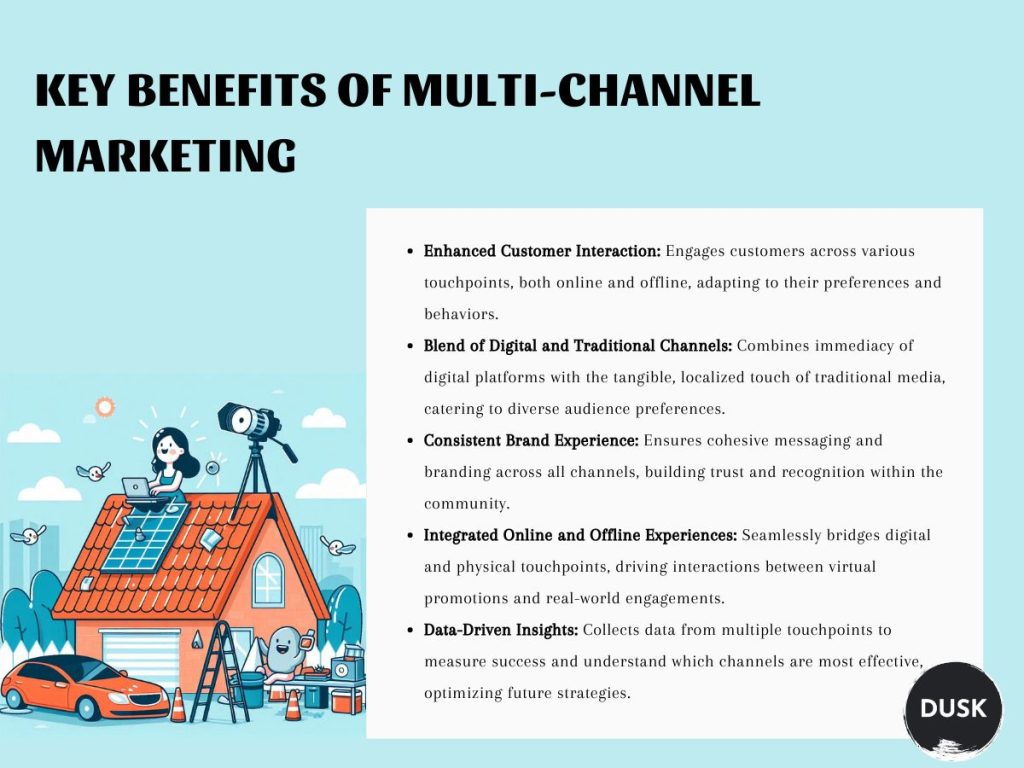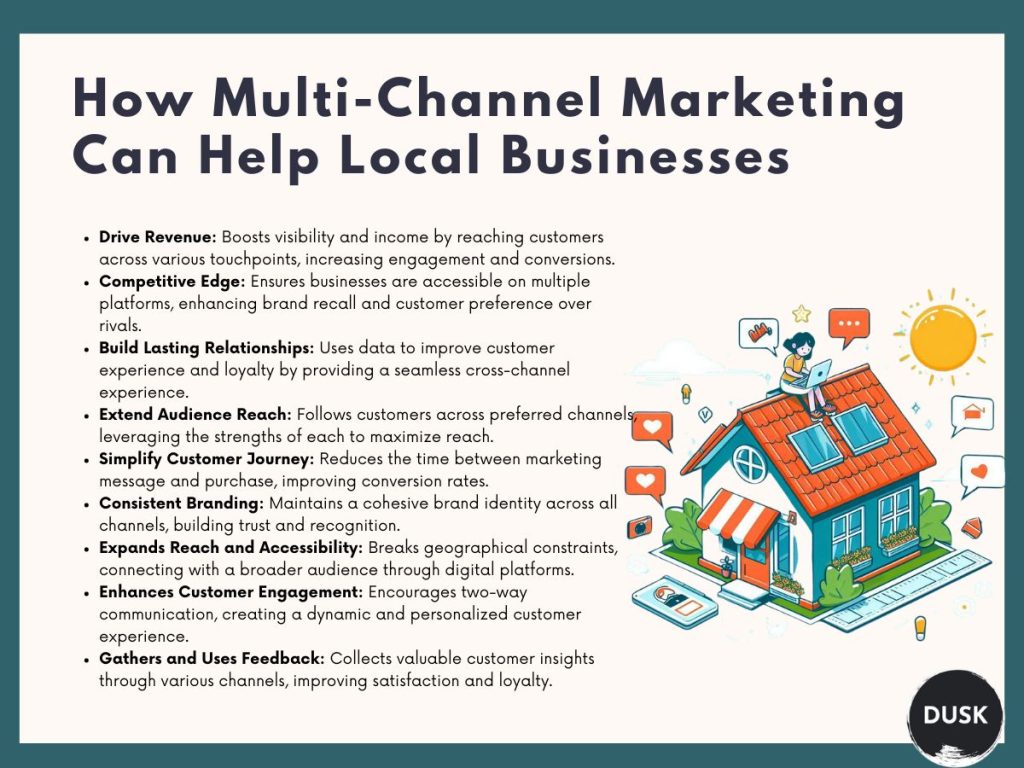Marketing is ever-evolving, with consumers navigating a multitude of online and offline channels, forcing businesses to adapt their strategies to engage a diverse and dynamic audience. Multi-channel marketing has emerged as a transformative approach, offering businesses the means to connect with customers seamlessly on various platforms.
The term “multi-channel marketing” describes the practice of conveying marketing messages using a variety of media platforms, such as display commercials on television, social media, print, mobile, and email. Using a variety of channels gives marketers the opportunity to communicate with consumers at many points of contact for a more thorough campaign.
Multi-Channel Marketing acknowledges that the modern consumer journey is complex, involving interactions with social media, email, websites, physical stores, and more. This approach seeks to integrate these diverse touchpoints into a cohesive strategy, fostering brand consistency, expanding reach, enhancing customer engagement, and optimizing efforts through data-driven insights.
The Key Benefits of Multi-Channel Marketing
Multi-Channel Marketing goes beyond the confines of singular platforms, integrating various channels to create a cohesive and engaging customer experience. Your potential clients could be anywhere, thanks to the vast array of marketing platforms available to you, so you need to be where they are.
Creating multi-channel marketing strategies will remain essential to retaining top-tier clients as the number of possible marketing channels increases (which it undoubtedly will).

1. Better Customer Interaction
At its core, Multi-Channel Marketing is about embracing the complexity of consumer behavior. It acknowledges that individuals today engage with brands through a myriad of touchpoints, both online and offline. This approach requires businesses to view their marketing efforts not as isolated campaigns but as interconnected elements contributing to a larger narrative.
Multi-channel marketing also recognizes the fluid nature of consumer behavior. With the rise of mobile technology, social media, and online shopping, consumers today expect businesses to be present where they are. This necessitates a strategic approach that adapts to the shifting preferences of the target audience.
2. Blends Digital and Traditional Channels
While digital channels like social media, email, and online advertising provide the immediacy and interactivity necessary for today’s fast-paced consumer environment, traditional channels such as print media, radio, and local events bring a tangible and localized touch. The synergy between these channels allows businesses to reach a diverse audience, considering the varied preferences and habits of their customer base.
Giving customers options for how they want to interact with your business allows them to use the medium that best suits them, which increases the likelihood that a conversion will be completed.
3. Creates a Consistent Brand Experience
Inconsistencies in messaging or branding can lead to confusion and dilution of brand identity. For local businesses, this cohesiveness is particularly crucial as it helps build trust and recognition within the community. Whether a customer encounters the brand on social media, through an email newsletter, or at a local event, the messaging should align seamlessly, reinforcing the core values and promises of the business.
Gaining traction and increasing brand awareness is a result of having multiple avenues of access. Managing your company’s reputation across multiple platforms allows you to maintain brand consistency whenever you use multi-channel marketing.
4. Integrates Online and Offline Experiences
The distinction between online and offline experiences is increasingly blurring in the Multi-Channel Marketing landscape. A successful strategy seamlessly integrates both realms, acknowledging that customers often transition between digital and physical touchpoints.
Local businesses, in particular, can benefit from this integration by creating a cohesive narrative that bridges the gap between their online presence and physical storefront. For example, a social media promotion can drive foot traffic to a brick-and-mortar store, creating a symbiotic relationship between virtual and real-world interactions.
You may gather more data by including more touch points in your marketing funnel. You can use this data to gauge your success and gain a better understanding of the areas where your promotions are most effective.
How Multi-Channel Marketing Can Help Local Businesses
The internet provides an abundance of avenues for businesses to reach out to consumers and increase the alternatives available for them to respond, mostly by making a purchase on the platform of their choice. You may engage with your clients on a regular basis by making use of the numerous channels that they use and the increasing number of new ones that appear daily.
Whether your company is an online retailer or a physical store, expanding is dependent on the multi-channel marketing model. This tactic gives your customers the freedom to select the location, time, and method of their purchases.

1. Drive Revenue
Every business wants to increase its revenue, which can greatly be done through multi-channel marketing. Since customers ultimately hold the power, they essentially have a big say in how successful a business is.
For this reason, it’s critical for businesses to constantly be where their clients are. Customers are scattered across various channels, both online and offline, which is where multi-channel marketing comes as a bridge to the businesses and customers where they are most active.
Putting your product or service in front of customers through multi-channel marketing promotes visibility, helps firms reach more people quickly, and boosts income. Whether it’s through social media engagement, search engine visibility, or community events, businesses can intercept their audience at different touchpoints, increasing the likelihood of engagement and conversion.
2. Keeping a Competitive Edge
Since mobile users interact on a variety of platforms these days, businesses cannot afford to be completely absent from the internet. Sadly, not many companies have adopted this philosophy, so it’s fortunate for those who are open to the shift.
Businesses that make themselves accessible to clients on a variety of platforms can acquire a competitive edge. Customers will not only remember your company more, but they will also be more inclined to make a purchase from you than from your rivals.
Although there are several advantages to multi-channel marketing, the most significant one is the way that all of the channels collaborate during a single campaign. If you’re starting a sales drive, for instance, you could send out emails showcasing your products and, just minutes after they receive them, text them with a discount code via SMS.
3. Build Lasting Relationships
Having a multi-channel marketing plan gives you access to data that not only improves your understanding of your target audience but also identifies the best channels to approach them on.
When your adverts are seamlessly integrated across your customers’ devices, you will essentially improve their experience. Customer loyalty directly results from a pleasant customer experience, which also enhances the brand-consumer relationship.
Providing a cross-channel experience to your clients could mean the difference between them abandoning their carts and completing the purchase. It’s simpler to use multi-channel marketing for retargeting when you and your customers get along well.
4. Extend Your Audience Reach
The largest issue with marketing through a single channel is that you lose customers when they switch to another preferred channel. Each marketing channel may be excellent in some situations but subpar in others.
With multi-channel marketing, you can find and reach your leads on any channels they interact with and move with them. You can also take advantage of the positive features of different channels while mitigating those situations where it falls short.
You may focus on the channels that matter most to your customers and follow them wherever they go by integrating multi-channel marketing with your customer data platform (CDP). Only with a multi-channel marketing plan will your brand be able to capitalize on each channel’s advantages while mitigating its drawbacks.
5. Simplify The Customer Journey
You are aware of the significance of the interval between a customer’s sight of a marketing message and their actual purchase. They are more likely to talk themselves out of purchasing if it takes them longer to confirm their transaction.
Regular audits of marketing materials across channels can ensure that deviations are identified and corrected promptly. Businesses can also solicit customer feedback to gauge their brand’s user-friendliness.
Multi-channel marketing lets you reach your customers on the channel they prefer to shop and send them direct, relevant links. This strategy means you can send them straight from the marketing team to the sales team with little wasted time.
6. Makes Your Brand Consistent
Consistency in branding is not merely about using the same logo or color palette across different channels; it extends to the entirety of the brand’s visual and verbal identity. It encompasses the tone of voice in communication, the imagery used, and the overall narrative that the brand weaves.
Brand consistency breeds trust whereby when customers encounter a familiar visual or verbal cue across various channels, it instills a sense of reliability and professionalism. Local businesses, in particular, can leverage this trust to establish themselves as pillars of the community.
For local businesses, this consistency serves as a beacon of recognition, allowing customers to easily identify and recall the brand amidst the noise of competing messages. Whether it’s through a well-designed website, social media posts, or local advertisements, the repetition of consistent branding elements reinforces the business’s commitment to its identity and promises.
7. Expands Reach and Accessibility
Local businesses often grapple with the challenge of reaching a wider audience beyond their immediate vicinity. Multi-Channel Marketing provides a strategic solution by breaking down geographical constraints.
Through online platforms such as social media, search engines, and email marketing, businesses can extend their reach to individuals who may not have been within the geographical scope of traditional marketing efforts. This digital outreach becomes a virtual storefront, enabling businesses to connect with potential customers globally.
8. Enhances Customer Engagement
Multi-channel marketing redefines the traditional model of one-way communication, where businesses broadcast messages to passive audiences. Instead, it encourages a two-way dialogue between businesses and customers. This shift is crucial in building relationships, as customers today seek more than just products or services—they desire a personalized and interactive experience.
Through channels such as social media, email, and customer feedback platforms, businesses can invite, acknowledge, and respond to customer input, creating a dynamic and engaging environment. Beyond being channels for promotional content, platforms like Facebook, Instagram, and Twitter facilitate interactive experiences. Businesses can leverage polls, contests, live videos, and user-generated content to actively involve their audience.
9. Gathers and Uses Customer Feedback
Customer feedback is a goldmine of insights for businesses, and Multi-Channel Marketing facilitates the collection of feedback through various channels. The ultimate goal of customer feedback in Multi-Channel Marketing is to cultivate a satisfied customer community.
Happy customers are more likely to become loyal advocates who make repeat purchases and actively promote the brand within their networks. Whether it’s through online surveys, social media comments, or reviews on third-party platforms, businesses can gather valuable information about customer preferences, expectations, and pain points.
9 Metrics to Measure Content Marketing Effectiveness
In a world saturated with information, customers are scattered across various channels, both online and offline. Multi-Channel Marketing acknowledges this dispersion and positions businesses to meet customers where they are most active.
Whether it’s through social media engagement, search engine visibility, or community events, businesses can intercept their audience at different touchpoints, increasing the likelihood of engagement and conversion. This approach ensures that the business remains visible and relevant in the constantly evolving landscape of consumer behavior.
How can you guarantee the effectiveness of your multi-marketing strategies? Compared to traditional advertising, content marketing produces three times as many leads on average. Thankfully, there are a number of measures available to gauge the success of content marketing and establish if you’re headed in the correct direction.






